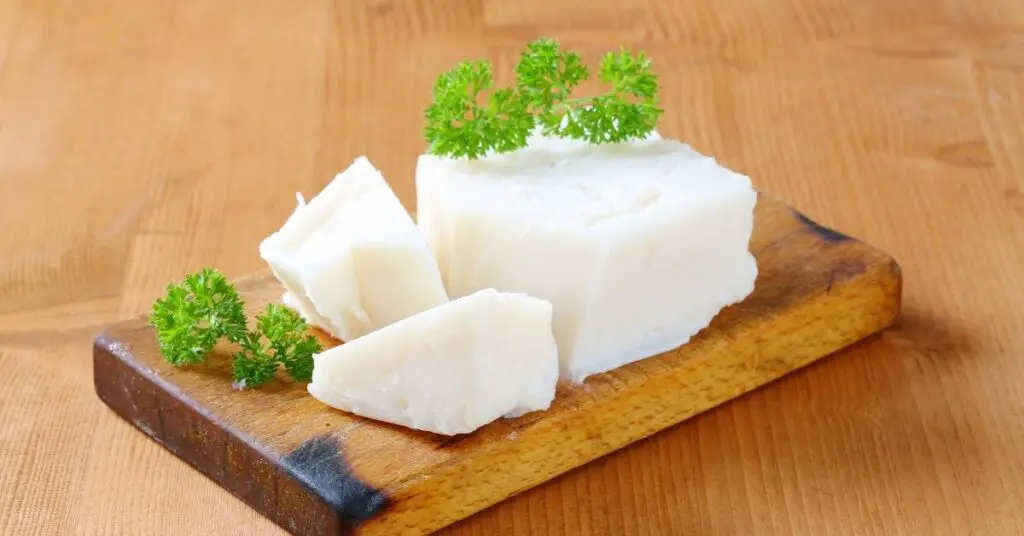Lard can last up to 6 months at room temperature and 2 years when frozen.
How Long Does Lard Keep?
Lard, despite its old-fashioned reputation, is making a serious comeback in kitchens! Heck, it’s incredibly versatile and has a surprisingly long shelf life compared to many other cooking fats. But with all the different storage options, knowing exactly how long your lard will last can get confusing.
Let me break down how long your lard’s good for depending on where you stash it, plus some insider tips to keep it fresh:
Lard 101: What You Need to Know
Before we dive into storage specifics, let’s get on the same page about lard.
- What it is: Lard is pure rendered pork fat. Traditionally it comes from the fatty parts around the pig’s kidneys and loin.
- Types: You’ll find two main types:
- Store-bought lard: This usually comes in shelf-stable tubs and often has added hydrogenated fats, which further extends its lifespan.
- Homemade lard: Made by carefully rendering pork fat yourself, this kind is all-natural but needs more careful storage.
Room Temperature Storage
Believe it or not, lard will keep at room temperature for a good while – just think like folks did way back before fridges existed!
Here’s what to expect:
- Store-bought lard: A good rule of thumb is about 6 months unopened, and maybe a month or two after opening. Always check the best-by date on the container.
- Homemade lard: Rendered properly, expect roughly 3 months at room temperature.
Pro tips for room temp:
- Cool, dark place: Think your pantry or a cellar, out of direct sunlight.
- Airtight container: Mason jars or the original container (if it reseals well) work great.
Refrigerator Storage
Popping your lard in the fridge significantly boosts its shelf life. Here’s the breakdown:
- Store-bought lard: Up to a year, sometimes even longer depending on the specific brand.
- Homemade lard: Can easily last a full year, if not a bit longer.
Storing it right:
- Airtight is key: Again, prevent rancidity by keeping it sealed from the air.
Freezing – The Ultimate Preservation Method
Need to store your lard for ages? The freezer is your best bet! Here’s how long it’ll stay good:
- Both store-bought and homemade: At least two years, and honestly, even longer if well-sealed.
Freezing tips:
- Small portions: Freeze in ice cube trays or small containers so you can thaw just what you need.
- Vacuum seal: If you have the equipment, this is the best way to prevent freezer burn.
How to Tell If Lard Has Gone Bad
Even with the best storage, lard will eventually go bad. But don’t worry, it’s usually super obvious:
- Smell: Rancid lard has a funky, sour, or almost chemical smell. If it’s off, you’ll know!
- Color: Fresh lard is white or creamy colored. Yellowing or discoloration is a bad sign.
- Texture: If it’s grainy, discolored in spots, or has any mold growth… toss it.
Important Note: Always give your lard a quick sniff before using it, even if it’s within the estimated storage time.
Table 1: Shelf Life at a Glance
| Storage Method | Store-Bought Lard | Homemade Lard |
| Room Temperature (65-75°F) | 6 months unopened, 1-2 months opened | Up to 3 months |
| Refrigerator (35-40°F) | Up to a year or more | Up to a year or more |
| Freezer (0°F) | At least 2 years | At least 2 years |
Maximizing Lard’s Freshness
Now that you know the basic storage guidelines, let’s go the extra mile to make your lard last as long as possible:
- Start with good quality: Whether you buy it or render it yourself, the fresher the lard starts, the longer it will keep. If making it at home, follow proper rendering techniques.
- Light exposure is the enemy: Light speeds up rancidity, so that opaque container in a dark place is your lard’s best friend.
- Minimize temperature changes: Keep it stored at a consistent temperature. The less it fluctuates, the better.
- Avoid cross-contamination: Use clean utensils every time you dip into your lard to prevent introducing bacteria.
Frequently Asked Questions About Lard
Let’s clear up some common confusion about lard storage:
1. Can I store lard in glass jars?
Absolutely! Glass jars, especially mason jars are perfect for lard. They’re non-reactive, airtight, and easy to clean.
2. My lard solidified in the fridge, is that normal?
Totally! Lard becomes solid when chilled, just like coconut oil. This doesn’t affect its quality. Just scoop out what you need or let it come to room temperature to soften.
3. Can I refreeze thawed lard?
Technically yes, but it’s not ideal. Refreezing can affect texture and potentially shorten its lifespan a bit. It’s best to just thaw what you’ll use within a few days.
4. Is lard healthier than butter or oils?
That’s a bit complex! Lard is surprisingly lower in saturated fat than butter, and it has a high smoke point, making it great for high-heat cooking. However, it’s still a form of fat, so moderation is key.
Table 2: Comparison of Lard, Butter, and Vegetable Oil
| Characteristic | Lard | Butter | Vegetable Oil (Canola) |
| Type of Fat | Mostly Monounsaturated and Saturated | Mostly Saturated | Mostly Polyunsaturated |
| Smoke Point | High (370°F) | Medium (350°F) | High (400°F+) |
| Flavor | Mild | Rich, Buttery | Neutral |
| Shelf Life (Room Temp) | Long | Shorter | Varies |
Conclusion- How Long Does Lard Keep?
How long does lard keep? Well, the answer depends on the type of lard and how you store it. At room temperature, in the fridge, or the freezer, proper handling means you can enjoy this amazing cooking fat for an impressively long time.

